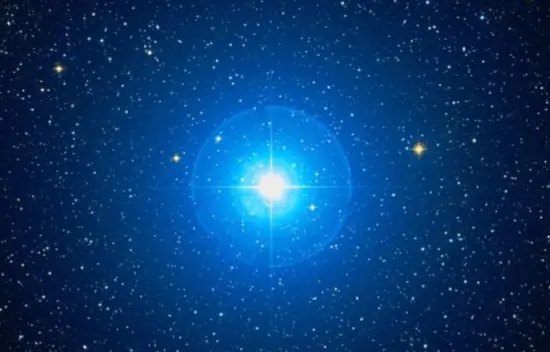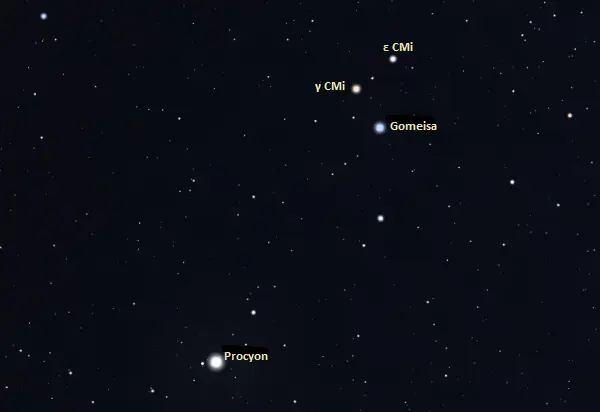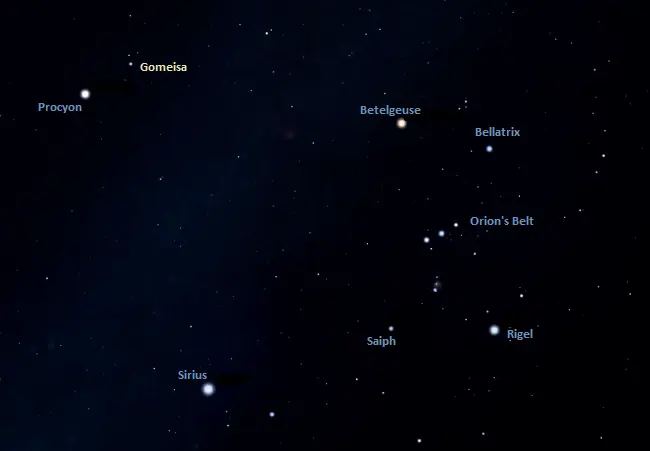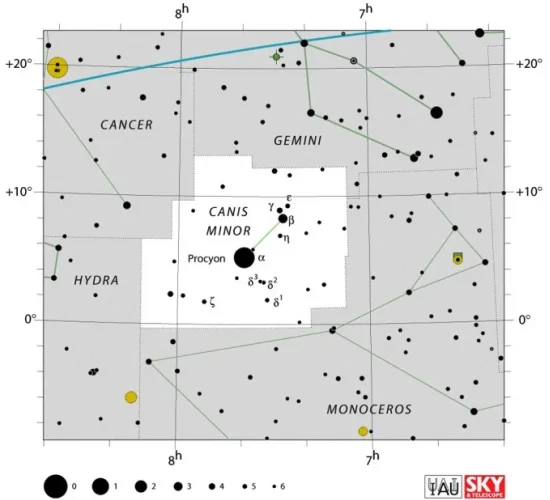Gomeisa, Beta Canis Minoris (β CMi), is a hot blue main sequence star located about 160 light years away in the constellation Canis Minor. With an apparent magnitude that varies between 2.84 and 2.92, it is the second brightest star in Canis Minor, after Procyon. It appears close to Procyon in the sky and marks the Lesser Dog’s neck.
Star type
Gomeisa is a luminous blue main sequence star of the spectral type B8 Ve. It has a mass of 3.5 solar masses and a radius 3.5 times that of the Sun. It shines with 195 solar luminosities with a surface temperature of 11,772 K. The star’s estimated age is about 160 million years.
The ‘e’ in Gomeisa’s spectral classification indicates emission lines in the star’s spectrum. This means that Gomeisa is a Be star and has a hot gaseous disk formed of expelled material as a result of rapid rotation.
Gomeisa is an exceptionally fast spinner, with a projected rotational velocity of at least 210 km/s at the equator. The circumstellar disk of expelled gas has a radius three times that of the star.

Gomeisa (Beta Canis Minoris), image: Wikisky
Gomeisa is classified as a Gamma Cassiopeiae variable and slowly pulsating Be star (SPBe). Named after prototype Gamma Cassiopeiae, γ Cas variables vary in brightness by about a magnitude on a timescale of decades. The variations are caused by changes between normal absorption spectra and Be star spectra. Many stars of this type have equatorial disks due to the rapid rotation of the photosphere. Bright examples of this class include Pleione, Kappa Canis Majoris, Lambda Pavonis, and Phi Persei.
Slowly pulsating B-type stars are long-period pulsating stars of spectral type B. They pulsate on a timescale between half a day and five days and usually have multiple periods of oscillations. Their brightness typically varies by less than 0.1 magnitudes. Other stars in this class include Homam (Zeta Pegasi), Omicron Velorum, Gamma Muscae, and Tau Herculis.
Facts
Gomeisa appears close to the brighter Procyon in the sky. It appears fainter than Procyon only because it is much more distant. Located only 11.46 light-years away, Procyon is one of the nearest stars to the Sun. It is a first-magnitude star because of its proximity. However, it is only 6.93 times more luminous than the Sun, while Gomeisa has an energy output 195 times solar with more than twice Procyon’s mass.

Procyon and Gomeisa, image: Stellarium
Even though it was classified as a Gamma Cassiopeiae variable in 1977, Gomeisa was found not to vary in brightness at all by several studies. However, a 2017 study detected changes in the hydrogen emissions from the circumstellar disk. These were found to be less pronounced than in many other Be stars.
The same study found that the Be disk was truncated at a finite radius from the star, indicating that Gomeisa may have an unseen companion. The researchers concluded that the companion would have a mass of about 0.42 solar masses, and that Gomeisa may be a product of binary evolution. If the two stars were close enough to be affected by each other’s presence, the companion may have filled its Roche lobe, and gas from its outer layers was transferred to Gomeisa. The overflow has spun up the fast-spinning Be star, leaving a hot O-type subdwarf or white dwarf companion orbiting the star.
The presence of the companion has not been directly confirmed. If one exists, Gomeisa likely had a similar evolution to Phi Persei, another hot blue star that spins at a critical rotation rate. Phi Persei accreted mass from its companion, a class O subdwarf hotter, smaller, and less massive than the primary.
A 2007 study used data obtained with the Microvariability and Oscillations of Stars (MOST) satellite and found low-amplitude light variations with periods of about 0.3 days. The scientists detected non-radial gravity-mode (g-mode) pulsations, confirming that Gomeisa belongs to the class of slowly pulsating Be stars (SPBe).
Name
The name Gomeisa (pronunciation: /ɡɒˈmaɪzə/) comes from the Arabic phrase al-ghumaisa’, meaning “the bleary-eyed (woman).” The meaning has also been interpreted as “the weeping one” or “the watery-eyed one.”
The name was approved by the International Astronomical Union’s (IAU) Working Group on Star Names (WGSN) on July 20, 2016. It formally applies only to the component Beta Canis Minoris A but has traditionally been used for the whole system.
The name is associated with an Arabic story of two sisters, represented by Gomeisa and Sirius, and their younger brother Suhail (Canopus). In the story, Canopus falls in love with Al Jaouza (Orion) and the two decide to get married. On their wedding day, he accidentally hits his bride, and she falls and meets her end. Bereft and deeply ashamed, Canopus flees across a light blue river (the Milky Way) and goes south, where no one would know him. Sirius follows him across the river and Gomeisa is left alone, grieving the separation from her sister and brother. Her eyes are dimmed with sorrow and she does not shine as bright in the night sky as she used to.
In Chinese astronomy, Gomeisa was known as 南河二 (Nán Hé èr), the Second Star of South River. The name refers to an asterism formed by Procyon (Alpha Canis Minoris) with Gomeisa and Epsilon Canis Minoris. The asterism was part of the Well mansion, one of the southern mansions of the Vermilion Bird.
Location
Gomeisa is very easy to find because it is bright and lies in an area full of first-magnitude stars. It can be identified using the stars of the Winter Triangle: Procyon, Betelgeuse, and Sirius. Sirius is the brightest star in the sky. It appears along the imaginary line extended from the three stars of Orion’s Belt. Betelgeuse sits at the shoulder of Orion, above the Belt stars, and Procyon appears left of Betelgeuse. Procyon and Betelgeuse are the 8th and 10th brightest stars in the sky.
Gomeisa is the brightest star near Procyon, in the direction of Alhena in Gemini.

The location of Gomeisa in the sky, image: Stellarium
Constellation
Gomeisa is located in the constellation Canis Minor. It marks the Lesser Dog’s neck. Representing the smaller of two Orion’s dogs, Canis Minor is the 71st constellation in size, stretching across only 183 square degrees of the predominantly northern sky. It is one of the 15 constellations on the celestial equator, visible from most places on Earth for at least part of the year.
Canis Minor is best known for being home to Procyon, the eighth brightest star in the sky and one of the nearest stars to the solar system, located 11.46 light-years away. The constellation also contains Luyten’s Star, a red dwarf only 12.348 light-years away, that hosts a planetary system.

Canis Minor constellation map by IAU and Sky&Telescope magazine
Canis Minor does not contain any particularly bright deep sky objects. It is home to the spiral galaxy NGC 2485, the interacting galaxies NGC 2402, and the lenticular galaxy NGC 2508.
The best time of the year to observe the stars and deep sky objects of Canis Minor is during the month of March, when the constellation is high above the horizon in the evening sky. The entire constellation is visible from all locations north of the latitude 75° S.
The 10 brightest stars in Canis Minor are Procyon (Alpha CMi, mag. 0.34), Gomeisa (Beta CMi, mag. 2.84 – 2.92), Gamma Canis Minoris (mag. 4.33), HD 66141 (mag. 4.39), 6 Canis Minoris (mag. 4.55), Epsilon Canis Minoris (mag. 5.002), Zeta Canis Minoris (mag. 5.13), Eta Canis Minoris A (mag. 5.25), Delta1 Canis Minoris (mag. 5.25), and 11 Canis Minoris (mag. 5.25).
Gomeisa – Beta Canis Minoris
| Spectral class | B8 Ve |
| Variable type | Gamma Cassiopeiae, slowly pulsating Be star (SPBe) |
| U-B colour index | −0.28 |
| B-V colour index | −0.09 |
| Apparent magnitude | 2.84 – 2.92 |
| Absolute magnitude | -0.59 |
| Distance | 160 ± 10 light-years (49 ± 3 parsecs) |
| Parallax | 20.3535 ± 1.2220 mas |
| Radial velocity | +22 ± 5 km/s |
| Proper motion | RA: −59.375 ± 1.708 mas/yr |
| Dec.: −35.010 ± 1.368 mas/yr | |
| Mass | 3.5 M☉ |
| Luminosity | 195 L☉ |
| Radius | 3.5 R☉ |
| Temperature | 11,772 K |
| Age | 160 million years (100 – 180 million years) |
| Rotational velocity | 210 km/s |
| Surface gravity | 3.51 cgs |
| Constellation | Canis Minor |
| Right ascension | 07h 27m 09.0417373s |
| Declination | +08° 17′ 21.536745″ |
| Names and designations | Gomeisa, Beta Canis Minoris, β CMi, 3 Canis Minoris, HD 58715, HR 2845, HIP 36188, SAO 115456, FK5 285, PPM 152663, BD+08°1774, AG+08 981, GC 9947, GCRV 4951, JP11 1553, IRAS 07244+0823, 2MASS J07270905+0817216, PLX 1753.00, UBV 7201, AAVSO 0721+08, TYC 764-2774-1, Gaia DR3 3143264535611892096, CCDM J07272+0818A, IDS 07217+0829 A, WDS J07272+0817A |